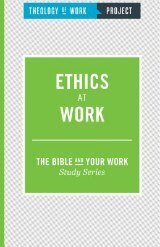Making Sense of Your Life: The High Calling of Reconciliation (2 Corinthians 5 Sermon Notes)
Sermon Notes / Produced by partner of TOW
II Corinthians 5:14-20
For Christ’s love compels us, because we are convinced that one died for all, and therefore all died. And he died for all, that those who live should no longer live for themselves but for him who died for them and was raised again. So from now on we regard no one from a worldly point of view. Though we once regarded Christ in this way, we do so no longer. Therefore, if any is in Christ, he is a new creation; the old has gone, the new has come! All this is from God, who reconciled us to himself through Christ and gave us the ministry of reconciliation: that God was reconciling the world to himself in Christ, not counting men’s sins against them. And he has committed to us the message of reconciliation. We are therefore Christ’s ambassadors, as though God were making his appeal through us. We implore you on Christ’s behalf: Be reconciled to God.
Central Truth:
Our wounded past can be healed if in the present reality we act with a courageous faith that is contrary to what caused the past failures. This is the high calling of reconciliation to heal hurts and build hope in our fractured world.
Biblical Exposition:
II Corinthians 5:14 – Christ’s love for us “urges us” into the new life. (Rom. 5:8).
II Corinthians 5:14-16 – Christ’s death for us was the sacrificial breakthrough which set us free from sin’s death decree, (“one has died for all, therefore all have died”). Christ is the new Adam (Rom. 5:12-21; 1 Cor. 15:22 ff., 45-48). We are set free as we “die in Christ” (Gal. 2:20). Our new life in Christ is celebrated thru baptism (Rom. 6:1-11) which is an outward act of the believer’s inward decision to be reborn through faith in Christ’s life, death, and resurrection.
“From now on” we “see” through the new way of seeing made possible by Christ, which contrasts the way of knowing “according to the flesh”—knowing without reference to God— which leaves us struggling within the blinding limits of our self-defined points of view.
II Corinthians 5:17 “Therefore”—all of this is God’s miraculous way to make salvation real for each believer. “anyone”—no other religion offered this radical openness, which fits the size of God’s heart. This is personal transformation with public declarations—racial (Jew/Greek), economic (slave/free), gender (male/ female) (Gal. 3:28).
“in Christ”—a special term coined by Paul to express the intimate, mystical way Christ lives in every believer. Paul used “in Christ” 51 times through his writings.
“is a new creation”—God of the universe is the creator of each individual. Each believer is touched by God’s powers to create a new life. The person’s circumstances may not be new but the person living in those circumstances is new.
“the old has passed away, behold all has become new”—this is God’s reality. But for it to become our reality, we must see ourselves as God sees us. “Behold” emphasized that God is grabbing us by the collar to deliver the message. Pay attention.
II Corinthians 5:18-21 – “the ministry of reconciliation...Ambassadors”
Introduction:
“Reconciliation” is the title Jay Winik gave to the closing chapter of his excellent book April 1865: The Month That Saved America. In that book, he talks about how tragedies were absorbed and responded to in a way that revealed that America did not want perpetual civil war. With poignant insight, Winik retells a worship scene made profound because two men—one black and one white—led a congregation to trust in Christ’s resurrected presence rather than in the enslavement of people’s prejudices.
The scene unfolded on a Sunday in the sanctuary of St. Paul’s Episcopal Church in Richmond, Virginia. As the rector was set to serve communion and the white worshipers were prepared to take their assumed rightful place of being served before the black worshipers, a strange action redirected the attention of the congregation from the expected to the unexpected.
A distinguished looking black man rose from the side galley and walked directly to the altar to receive the symbols of Christ’s death and resurrection. His actions became a prophetic parable of biblical proportions. As Winik writes, “It was one thing for the white South to endure defeat and poverty or to accept the fact that slaves were now free; it was quite another for a black man to stride up to the front of the church as though an equal.”
While the black man knelt, the other worshippers seemed paralyzed. Then a white man—whose life had been radically reoriented from wealth to poverty, from a mansion in Arlington to homelessness in Richmond, from a generalship with the power to influence the fate of millions to the surrender of his command at Appomattox—broke the deadlock by an act of worship equal to that of his black brother. Robert E. Lee rose from his pew, walked to the altar and knelt to receive communion. In that moment, the promises of Christ’s presence possessed the power to resurrect a hopeful future from dead past. In that moment, reconciliation became possible.
Promise and Peril:
Reconciliation is the embodiment of God’s hope for a fractured world. God created us to be in a right relationship with him, with people, with creation, and with ourselves. Our happiness and fulfillment are determined by the quality of our relationships. The Bible highlights reconciliation as the harmonious restoration of a relationship with God (redemption) that provides the means by which barriers between people can be overcome.
The concept of reconciliation casts a vision for what can be when right relationships are restored. The work of reconcilers is required for this to be accomplished.
Yet, in this century as in all others, we live within the promise and peril of where human history has led us. In an era in which we are discovering cures to age-old diseases, we are also capable of destroying our world with weapons of mass destruction fueled by age-old hatreds. Today, communication technology so links the continents that we learn about what is happening on the other side of the world as quickly as what is happening next door, thus creating the context for living as a global village. The knowledge gained by instant communication helps us to empathize with the hopes and hurts of people groups whom we have never met in places we have never been. The empathy we feel can enable us to help each other in ways not previously thought possible. Yet, we are finding that this knowledge not only has the power to bind us together, but it also has the power to divide us. All too often, the disparity of economic opportunity, moral standards, and basic freedoms creates resentment. Indeed, Charles Dickens’ characterization of his year as “the best of times and the worst of times” in his book, A Tale of Two Cities, describes the opportunities and dangers of our present epoch of history as well.
In the midst of this ever-more-complex world, the clarion call to people of Christian faith is to model what it means for every human being to be made in God’s image, and therefore, for each to be valued equally. The dignity and human rights of all persons are to be affirmed. People of every skin color, every language, and every land are cherished by God and are to be cherished by us, his children.
As Christians, now is the time to address the patterns of human history which hinder us from God’s promise of the new reality prophesied by the Apostle Paul to regard no one from merely a human point of view but to live as a new humanity: “therefore if anyone is in Christ, he or she is a new creation; the old is gone, the new is come!”
The challenge is more than we can accomplish on our own, but in God’s power, the seemingly impossible is shown to be possible.
Such was the case when an unthinkable tragedy occurred in the fall of 2006 as five school girls were murdered in the Amish community of Nickel Mines, Pennsylvania. Later that year, Beliefnet, the nation’s leading religious and spirituality website, chose the people of that community as the most-inspiring persons of 2006. Why? Because, as Beliefnet’s CEO said, “The first thing they did was bring food and comfort to the family of the killer. Second, one of the little girls reportedly offered to be shot first, hoping to save other lives.... They were living their faith and exhibiting values we all wish we could live up to—personal commitment to forgiveness.” Forgiveness—the seemingly impossible—had been shown to be possible.
Steps to be taken:
Fresh steps can be taken for people in any time and in any place to live in right relationship with each other. The following eight-fold path of reconciliation emerges from the path revealed adventure, awareness, action, and actualization:
By listening and observing, be aware of when trust has become fragile. Become aware of the need for reconciliation by paying attention to the pain of others as well as your own pain. Pray for God’s insight to help you see what you cannot naturally see on your own, e.g., Matt. 7:1-5.
Ask and then listen to the person’s story. The story will trace the original hurt and subsequent anger. When the wound is not healed, regressive stages follow. Diagnose the stage, e.g., hurt, anger, resentment, despair, cynicism, apathy, revenge.
Summarize what the person/s has said so they know they have been heard. Do not be distracted from working towards the best-desired outcome. Your hope casts the vision.
Tell your story/perspective as it is helpful. Hope is the biblical vision that what is broken can be mended if we trust in God’s resources.
As needed, ask for forgiveness from the other person(s) and extend forgiveness to the other person(s).
Pray for God’s power to be released so the outcome may be realized. Visualize the reconciliation being actualized.
Agree on an action plan so trust has a resting place. Research and develop the needed skills to fulfill the newly formed covenant.
Faithfully commit to grow as a person of reconciliation as you work the covenant and are not distracted from achieving the desired outcome.
The Cross and Conclusion:
The Kingdom ethic for us is to love God with all our being so that we may see everyone as a neighbor we are to love, as we love ourselves. The cross’ intersection of the vertical and horizontal relationships—God with people, people with God—becomes our teacher. The cross demonstrates what Christ makes possible and then demands that we make application from his atonement. We are called to take up our cross and love the modern-day biblical version of those with cultural differences (Samaritans); those who have abused their positions of power (Zacchaeus); those repentant of sexual sins (the adulteress at Simon’s house); political enemies (Matthew the Tax collector and Simon the Zealot); and the socially despised (Mary Magdelene). Local reconciliation efforts are made real by real people who become reconcilers.
This was made ever so vivid to me in the experience of my father and one of his dearest friends, Judge Ken Muller. My late father worked for half a century as an attorney in the Texas Hill Country. He viewed himself as a social doctor. Judge Muller still occasionally visits Dad’s graveside to reminisce. The words on Dad’s tombstone read, “A lawyer statesman shaped by faith, freedom, family, and friends who was commended by the State Senate of Texas for his services to Boerne, Kendall County, Texas, and to the United States.” But Judge Muller and Gordon Hollon were not always the best of friends. Many years ago, their opposing views on selected political and legal issues shaped them into each other’s nemesis. They were good men with local power at a crossroads with each other.
Then during a Sunday morning worship service at Boerne’s First Baptist Church, God intersected them with grace and an opportunity for reconciliation. Ken, noticing that Dad had walked to the lobby, approached him and asked if they could talk about their relationship. Accepting the opportunity as a way to see their future differently from their past, Dad and Ken began talking by retracing the events which had shaped the negative conclusions about each other. Essentially, they were standing at the foot of the cross, confessing their sins, and asking the same question, “Help me understand?” And they reconciled.
*********************************************************************************************************
Leslie Hollon is a pastor, preacher, professor, and author. Leslie serves as Senior Pastor of Trinity Baptist Church in San Antonio, Texas, a growing regional congregation noted for the impact of its local and global ministries. Leslie writes in the areas of Christian faith & practice; has contributed to nine books plus several periodicals. Among his most recent releases was Christian Reconciliation Ministries: Healing Hurts and Building Hope. A graduate of Baylor University, Leslie holds the Master of Divinity, the Master of Theology, and the Doctor of Philosophy from Southern Seminary of Louisville, Kentucky. He was a founder of The Academy of Young Preachers.
Click here for a PDF of this sermon.
Other sermons in this series on Making Sense of Your Life:


.jpg)








